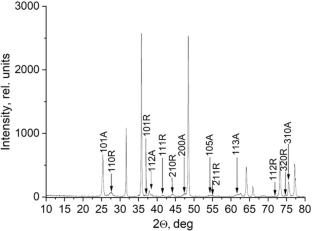Structure and properties of titanium and titanium oxide films formed on a substrate by vacuum-arc plasma-assisted method
Abstract
The paper presents an analysis of the results of a study on the structure and properties of thin films of titanium oxides (2–3 μm thick) deposited on the surfaces of Ti–6Al–4V titanium alloy and HG40 hard alloy samples using vacuum-arc plasma-assisted technique. It has been found that the deposition of both titanium and titanium oxide films results in the formation of particle droplet fractions the characteristics (the average, minimum, and maximum sizes and the number of particles per unit surface area) of which depend on the value of the “PINK” discharge current. The formed films are shown to be a single-phase material containing titanium dioxide (TiO2) in two modifications: rutile and anatase. The relative content of these two modifications in the film was found to depend on the discharge current value (Ip). It has been established that titanium and titanium oxide films have a columnar structure. The columns are formed by crystallites the dimensions of which are (3.1–5.4) nm in the titanium film and (18.3–20.5) nm in the titanium oxide film. It has been revealed that the maximum microhardness value of the film (TiO2)/(Ti–6Al–4V) substrate system is 9.5 GPa at Ip = 0 A. This value is more than twice the microhardness of the Ti–6Al–4V alloy. Additionally, the specific wear rate k, which is the inverse of the wear resistance, reaches a minimum value of 1.9·10−7 mm3/(N·m) at Ip = 0 A, and this value is more than 250 times lower than the wear parameter of Ti–6Al–4V. For the same spraying mode, the friction coefficient of the film is 0.43, which is 1.6 times less than the friction coefficient of the VT6 alloy and 1.3 times less than the friction coefficient of the titanium film.


 求助内容:
求助内容: 应助结果提醒方式:
应助结果提醒方式:


